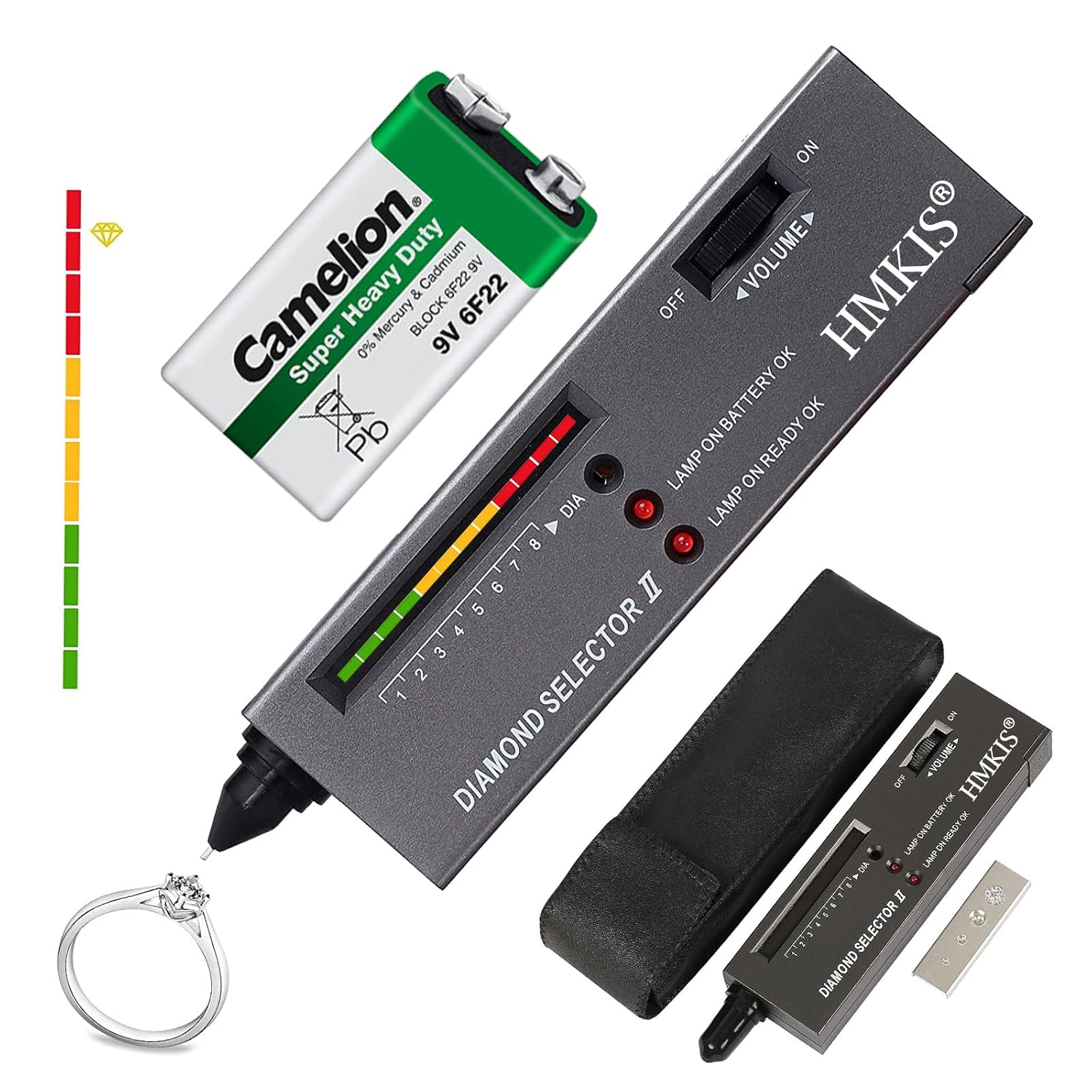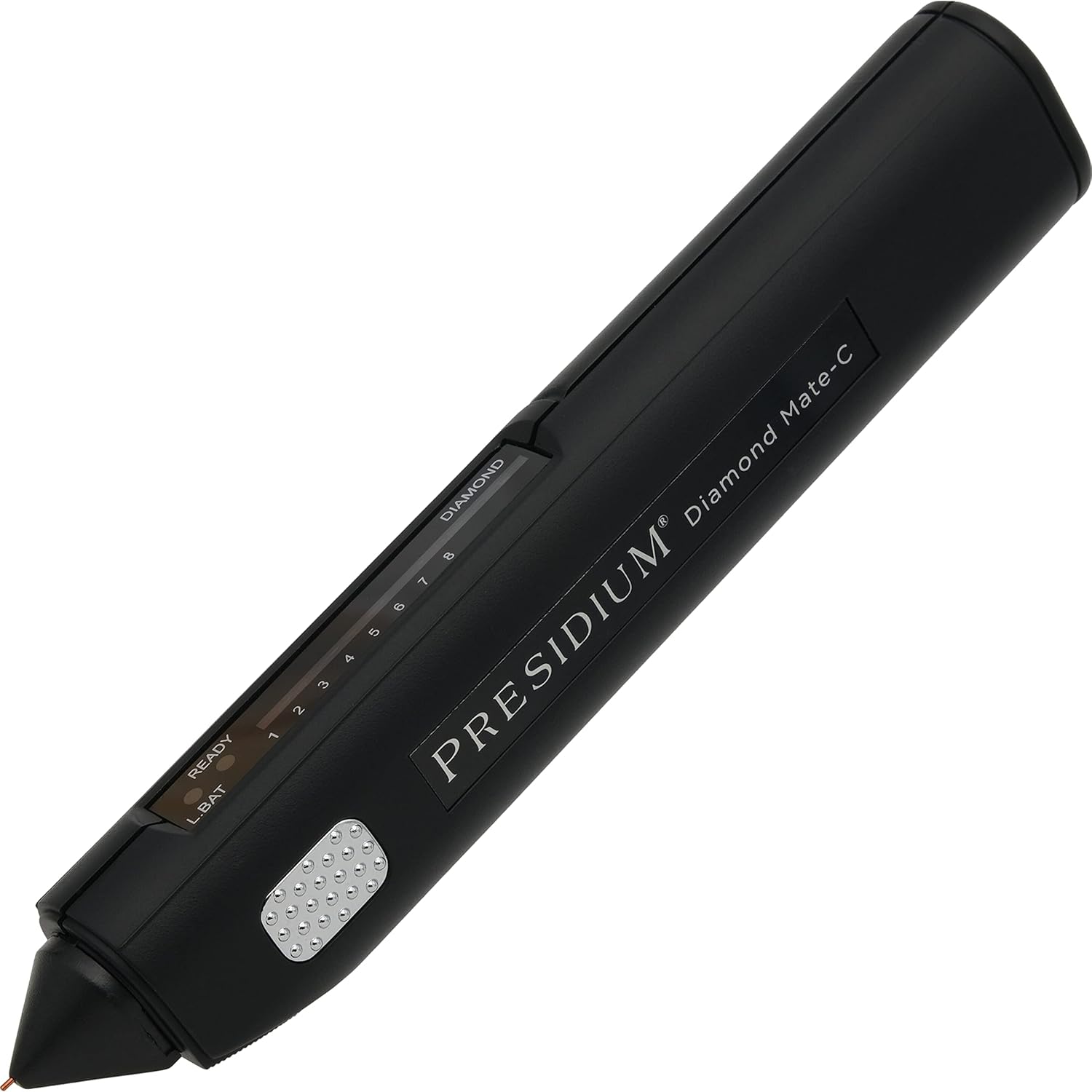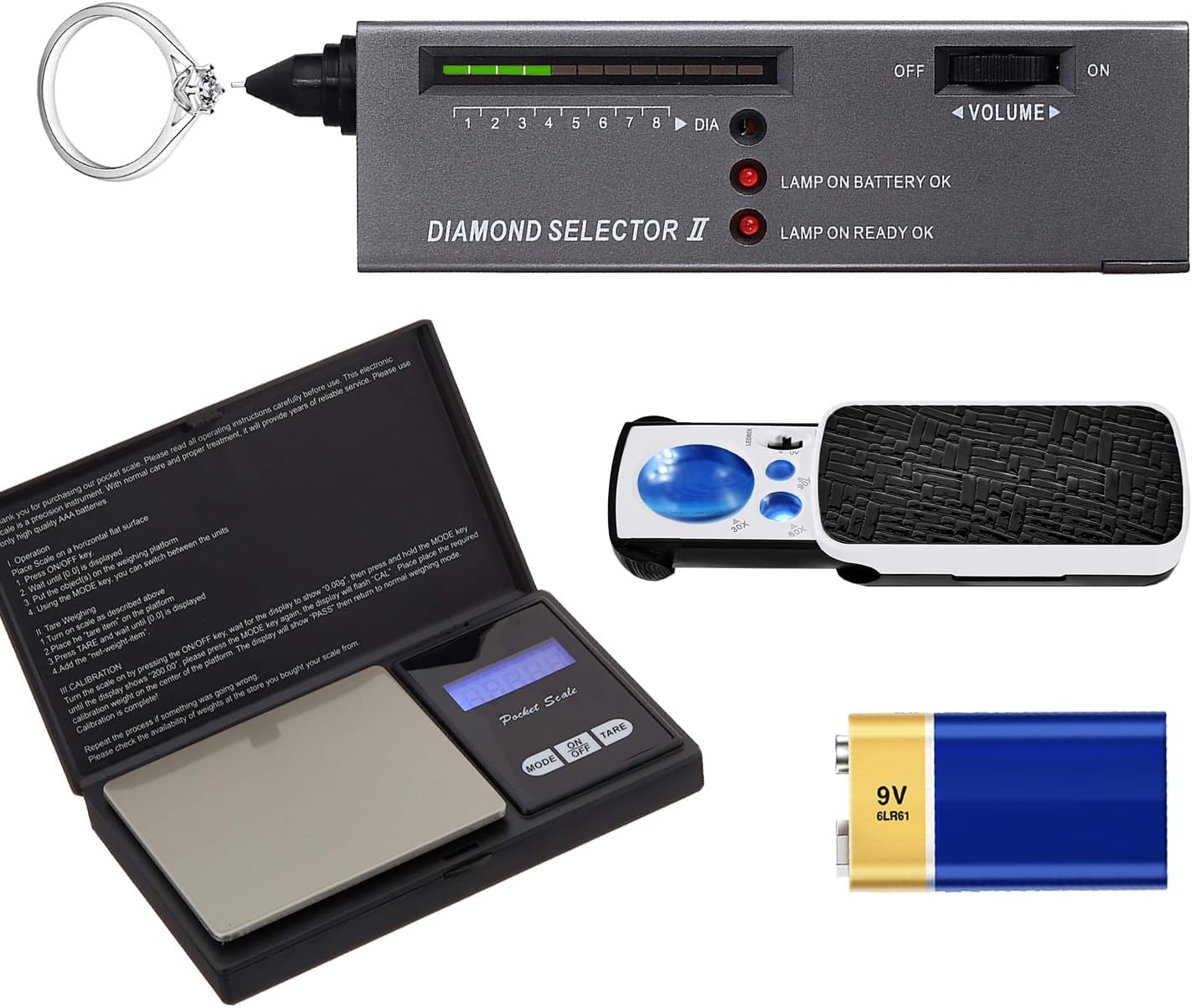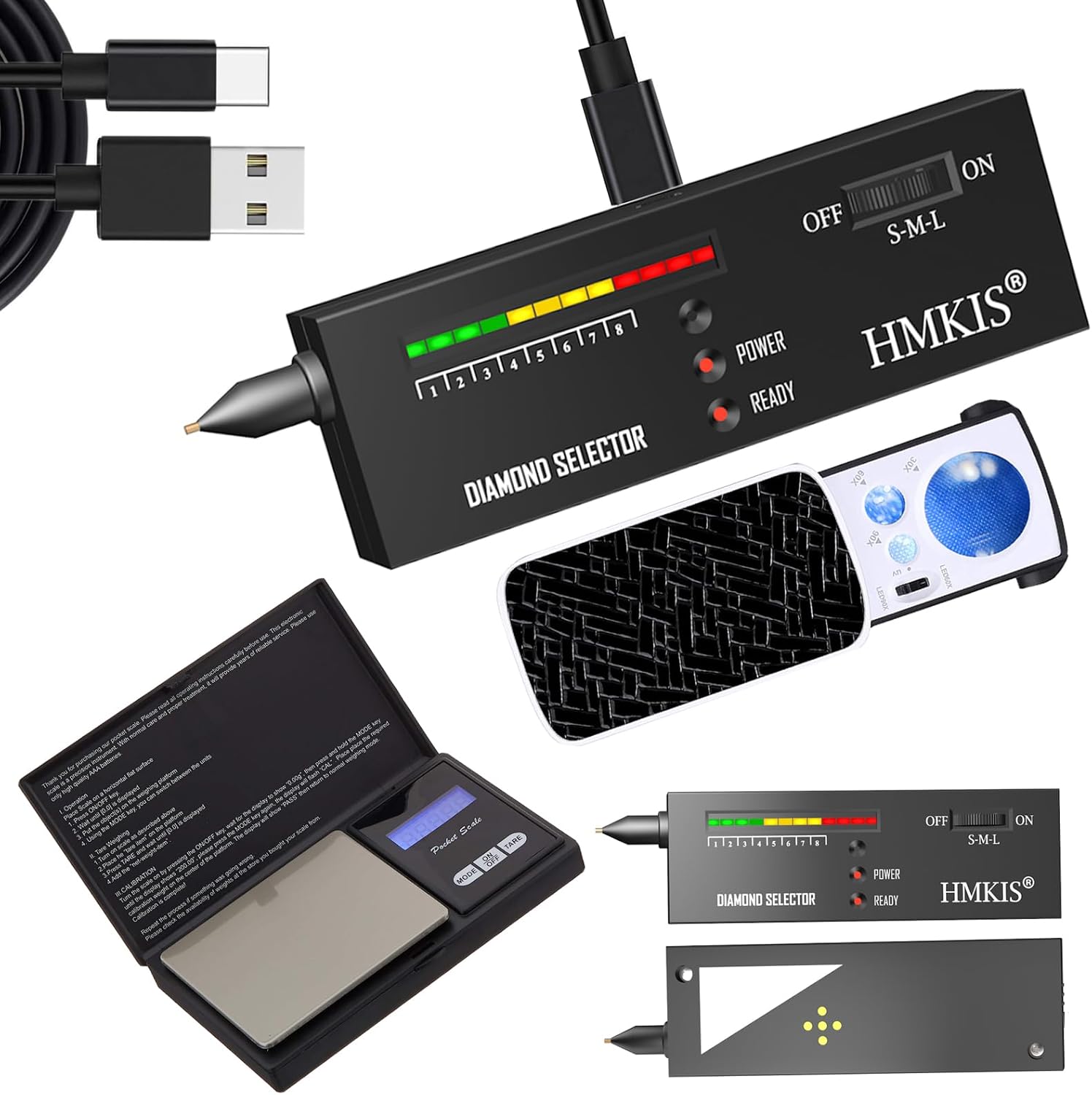Diamonds, often referred to as a girl’s best friend, are not just symbols of wealth and luxury; they are also significant investments. As such, the importance of diamond testers cannot be overstated. These devices play a crucial role in verifying the authenticity of diamonds, ensuring that you get value for your money. They are especially useful for diamond buyers, jewelers, and gemologists who need to ascertain the quality of diamonds.
The purpose of this article is to delve into the world of diamond testers. We will explore their importance, how they work, factors to consider when buying one, and how to use them effectively. We will also look at the limitations of diamond testers and discuss alternatives for testing diamond authenticity. By the end of this article, you will have a comprehensive understanding of diamond testers and their role in the diamond industry.
Our Top Diamond Tester Picks

Diamond Tester
Check on AmazonKey Specs
- Function: Detects diamonds vs imitation stones
- Power: Battery operated
- Alerts: Visual (LEDs) and Audio feedback
- Dimensions: 7.48 x 2.17 x 1.38 inches
- Note: Cannot detect moissanite or test metals with one hand
The HMKIS Diamond Tester is a practical tool for quick on-the-spot gem checks, but it does require some precision to use correctly. I like that it provides clear visual and audio cues to differentiate real diamonds from imitations like CZ or glass. The built-in metal alert buzzer is a smart touch—it prevents false positives by warning when the probe accidentally touches metal. Just keep in mind, it won’t distinguish moissanite from diamonds, and it must be held with both hands to function accurately.

Diamond Tester Pen+60X Mini LED Magnifying
Check on Amazon
Key Specs:
- Includes: Diamond tester pen and 60X magnifier
- Magnifier Features: Built-in LED and UV light
- Tester Alerts: Audio and visual indicators
- Power Source: Battery-operated
- Functionality: Detects diamonds vs fakes (not moissanite)
The Diamond Tester Pen + 60X Mini LED Magnifying Set offers a convenient duo for jewelry verification. I appreciate how this set combines thermal conductivity testing with magnified visual inspection. The diamond tester pen works best for identifying real diamonds through clear LED signals and sound cues, while the 60X magnifier helps spot inclusions or flaws that are typical in real stones. The built-in LED/UV light on the magnifier is a thoughtful feature for checking authenticity marks or fluorescence under different lighting conditions.

PRESIDIUM DIAMONDMATE-C ELECTRONIC DIAMOND TESTER
Check on Amazon
Key Specs:
- Power Source: Battery-powered
- Portable Design: Compact and easy to use
- Detection Method: Thermal conductivity
- Indicators: LED lights for clear signals
- Dimensions: 3.4 x 2.4 x 7.5 inches
The Presidium DiamondMate-C Electronic Diamond Tester is a portable, precision tool designed for those who need quick and accurate diamond identification. It utilizes thermal conductivity to distinguish diamonds from simulants like cubic zirconia. The tester is compact, with an ergonomic design, making it easy to carry and use in various settings, whether you’re a jeweler or a collector. One of its standout features is the clear LED indicator, which signals when a real diamond is detected. Its battery-powered operation ensures convenience during travel or on-site testing.

HMJOY Diamond Tester
Check on Amazon
Key Specs:
- Detection Method: Thermal conductivity
- Beeping Sound: Low frequency for diamonds
- LED Lights: 9+ lights indicate diamond size
- Magnification: 60X LED magnification for detailed inspection
- Pocket Scale: 200-gram max capacity, 0.01g increments
The HMJOY Diamond Tester is a reliable tool designed for identifying diamonds, including real diamonds and Moissanite. It operates with a simple two-hand method to ensure accurate results: one hand holds the diamond, while the other operates the tester. The tester emits a beeping sound with a low frequency for diamonds, accompanied by multiple LED lights that increase with the size of the stone. It also features a 60X LED magnification for inspecting small items like gems, coins, and stamps. Additionally, this set includes a pocket scale with a 200-gram capacity for precise measurements, ideal for weighing small objects.

HMKIS Diamond Tester
Check on Amazon
Key Specs:
- Detection Method: Thermal conductivity
- Beeping Sound: Low frequency for diamonds
- LED Lights: ≥8 red lights indicate diamond presence
- Magnification: 40X LED magnification for detailed inspection
- Pocket Scale: 200-gram capacity, 0.01g increments
The HMKIS Diamond Tester is a reliable tool designed to test diamonds by measuring thermal conductivity, although it cannot differentiate between Moissanite and diamonds due to their similar properties. Proper two-handed operation is crucial for accurate testing: one hand holds the diamond, while the other touches the tester’s conductive panel. Initialization is required before use. When testing diamonds, the tester will emit a low-frequency beep and light up at least 8 red lamps, with more lamps lighting up for larger stones. For diamond simulants, there is no beep or light indication. The tester also includes a pocket scale with a 200-gram capacity and 40X LED magnification for detailed inspection of various objects.
Understanding Diamonds
Diamonds have a rich history dating back thousands of years. They were first discovered in India over 2,000 years ago and were valued for their ability to refract light. Over the centuries, diamonds have been used in various ways, from religious icons to tools for engraving other materials. Today, they are most commonly used in jewelry and are considered a symbol of love and commitment.
Identifying real diamonds can be a complex process. Real diamonds have unique properties that set them apart from other gemstones and synthetic diamonds. For instance, they are the hardest known material, they have high refractive indices, and they conduct heat extremely well. These properties can be used to distinguish them from other stones. However, the most reliable way to verify a diamond’s authenticity is by using a diamond tester.
The Need for Diamond Testers
Verifying the authenticity of a diamond is crucial for several reasons. First, it ensures that you are getting what you paid for. With the high cost of diamonds, buying a fake or low-quality diamond can result in a significant financial loss. Second, it protects the integrity of the diamond industry. By ensuring that only real diamonds are sold, diamond testers help maintain consumer trust in the industry.
Buying diamonds without testing them carries several risks. There is a risk of purchasing a fake diamond, which is not only a financial loss but can also damage a jeweler’s reputation. There is also a risk of buying a diamond of lower quality than advertised. For instance, a diamond may be sold as a high-quality stone, but in reality, it may have flaws or inclusions that lower its value. Therefore, testing diamonds before buying them is essential.
What is a Diamond Tester?
A diamond tester is a portable electronic device used to distinguish real diamonds from other types of gemstones. It works by measuring the rate at which heat moves through the stone. Since diamonds conduct heat differently than other materials, this allows the tester to determine whether the stone is a real diamond or not.
There are different types of diamond testers available on the market. The most common type is the thermal conductivity tester, which measures how quickly heat is conducted through the stone. Another type is the electrical conductivity tester, which measures how well the stone conducts electricity. Some testers combine both methods for more accurate results.
How Does a Diamond Tester Work?
The technology behind diamond testers is quite fascinating. They work based on the principle that different materials conduct heat and electricity at different rates. Diamonds, being composed of tightly bonded carbon atoms, are excellent conductors of heat and relatively poor conductors of electricity. When a diamond tester is applied to a stone, it measures these properties and uses them to determine whether the stone is a diamond or not.
The process of testing a diamond involves several steps. First, the tester is calibrated using a calibration stone that comes with the device. Then, the tip of the tester is placed on the stone that is being tested. The tester then measures the rate of heat or electricity conduction and displays the result. If the stone is a diamond, the tester will indicate this, usually with a beep or a light.
Factors to Consider When Buying a Diamond Tester
When buying a diamond tester, several factors should be considered. First and foremost is accuracy. The tester should be able to accurately distinguish real diamonds from other stones. It should also be able to differentiate between natural diamonds and synthetic ones. Some testers are more accurate than others, so it’s important to do your research and choose a tester that is known for its accuracy.
Another important factor is ease of use. The tester should be easy to operate, even for someone who is not a professional jeweler. It should have clear instructions and a straightforward testing process. Durability is also important. The tester should be sturdy and durable enough to withstand regular use. Finally, price is a consideration. Diamond testers can range in price from around $20 to several hundred dollars. It’s important to choose a tester that fits within your budget but still offers the features and accuracy you need.
Top Diamond Tester Brands
There are several popular brands of diamond testers on the market. Some of the top brands include Presidium, GemOro, and HDE. These brands are known for their accuracy, reliability, and ease of use. They offer a range of testers, from basic models to more advanced ones that can test for a variety of gemstones.
When comparing diamond tester brands, it’s important to consider their features and prices. Some testers offer additional features, such as the ability to test for other gemstones or to differentiate between natural and synthetic diamonds. These features can be useful, but they may also add to the cost of the tester. Therefore, it’s important to consider what features you need and choose a tester that offers those features at a price you can afford.
How to Use a Diamond Tester
Using a diamond tester is a relatively straightforward process. First, the tester needs to be calibrated. This is usually done by adjusting the tester until it gives a positive reading when applied to a calibration stone. Once the tester is calibrated, it can be used to test diamonds. The tip of the tester is placed on the stone, and the tester measures the rate of heat or electricity conduction. If the stone is a diamond, the tester will indicate this.
For accurate testing, there are a few tips to keep in mind. First, make sure the stone is clean and dry before testing it. Dirt or moisture can affect the tester’s readings. Second, make sure the tester is properly calibrated before each use. Finally, always test the stone in multiple spots to ensure accurate results.
Common Mistakes When Using a Diamond Tester
While using a diamond tester is not overly complicated, there are a few common mistakes that people make. One of the most common mistakes is not properly calibrating the tester. If the tester is not calibrated correctly, it may give inaccurate results. Another common mistake is testing a dirty or wet stone. As mentioned earlier, dirt and moisture can affect the tester’s readings.
To avoid these mistakes, always make sure to calibrate the tester before each use. Also, clean the stone before testing it and make sure it is dry. Finally, always test the stone in multiple spots to ensure accurate results. By avoiding these common mistakes, you can ensure that your diamond tester gives you accurate and reliable results.
The Limitations of Diamond Testers
While diamond testers are a valuable tool for verifying diamond authenticity, they do have their limitations. For instance, they cannot determine the quality of a diamond. They can only tell you whether the stone is a diamond or not. They cannot tell you whether the diamond is of high quality or whether it has any flaws or inclusions.
Another limitation of diamond testers is that they cannot differentiate between natural and synthetic diamonds. Synthetic diamonds have the same physical properties as natural diamonds, so they will test as real diamonds. However, they are not as valuable as natural diamonds. Therefore, while a diamond tester can tell you whether a stone is a diamond, it cannot tell you whether it is a natural or synthetic diamond.
Alternatives to Diamond Testers
While diamond testers are the most reliable way to verify diamond authenticity, there are other methods that can be used. These include the water test, the fog test, and the scratch test. However, these tests are not as reliable as a diamond tester and can often give false results.
For instance, the water test involves dropping the stone into a glass of water. If the stone sinks, it is said to be a real diamond. However, many other heavy stones will also sink, so this test is not very reliable. The fog test involves breathing on the stone. If the fog disappears quickly, the stone is said to be a real diamond. However, this test can also give false results. The scratch test involves scratching the stone against a piece of glass. If the stone scratches the glass, it is said to be a real diamond. However, many other hard stones can also scratch glass, so this test is not very reliable.
Case Study: Successful Use of Diamond Testers
Despite their limitations, diamond testers have proven to be a valuable tool in the diamond industry. For instance, in 2017, a New York-based diamond dealer was able to identify a large batch of fake diamonds using a diamond tester. The dealer had purchased the diamonds from a supplier who claimed they were natural diamonds. However, when the dealer tested the diamonds with a diamond tester, he found that they were actually synthetic diamonds. Thanks to the diamond tester, the dealer was able to avoid a significant financial loss.
This case highlights the importance of using a diamond tester when buying diamonds. It also underscores the importance of buying diamonds from reputable suppliers. While a diamond tester can help identify fake diamonds, it is also important to do your due diligence and ensure that you are buying from a trustworthy source.
The Future of Diamond Testing
As technology advances, so does the field of diamond testing. New technologies are being developed that can not only identify fake diamonds but also determine the quality of diamonds. For instance, some companies are developing devices that can analyze the internal structure of diamonds to identify flaws and inclusions. These devices could revolutionize the diamond industry by making it easier to assess the quality of diamonds.
Another emerging technology in diamond testing is the use of spectroscopy. This involves analyzing the light spectrum that is reflected off the diamond. Different types of diamonds reflect light in different ways, so this can be used to identify the type of diamond. This technology could make it easier to differentiate between natural and synthetic diamonds, which is currently a challenge for diamond testers.
Conclusion
In conclusion, diamond testers are an essential tool for anyone involved in the buying or selling of diamonds. They provide a reliable way to verify the authenticity of diamonds, protecting buyers from fake or low-quality diamonds. While they do have their limitations, they are currently the most reliable method of testing diamond authenticity.
When choosing a diamond tester, it’s important to consider factors such as accuracy, ease of use, durability, and price. It’s also important to understand how to use the tester correctly and to be aware of common mistakes that can affect the tester’s accuracy. With the right diamond tester and the knowledge of how to use it, you can ensure that you are getting a real, high-quality diamond.
FAQ
What is a diamond tester?
A diamond tester is a portable electronic device used to distinguish real diamonds from other types of gemstones. It works by measuring the rate at which heat moves through the stone.
How does a diamond tester work?
A diamond tester works based on the principle that different materials conduct heat and electricity at different rates. When a diamond tester is applied to a stone, it measures these properties and uses them to determine whether the stone is a diamond or not.
What are the limitations of diamond testers?
Diamond testers cannot determine the quality of a diamond or differentiate between natural and synthetic diamonds. They can only tell you whether the stone is a diamond or not.
Are there alternatives to diamond testers?
Yes, there are other methods of testing diamond authenticity, such as the water test, the fog test, and the scratch test. However, these tests are not as reliable as a diamond tester.
